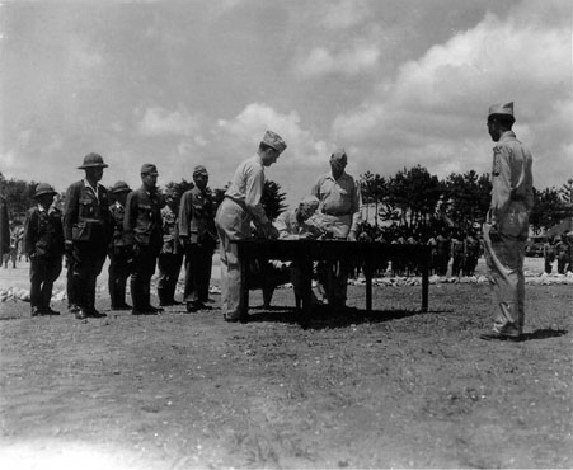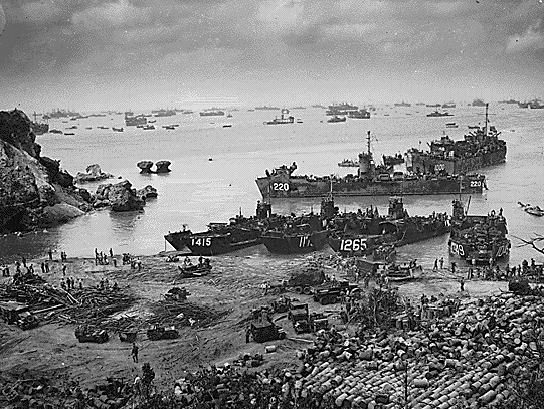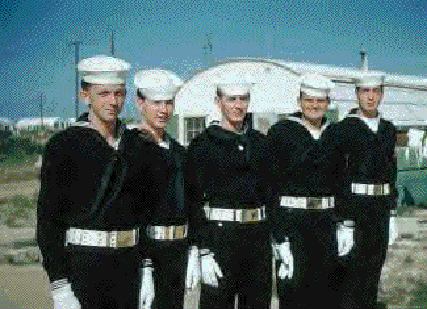Battle For Okinawa: World War II | home
Chronology of The Battle for Okinawa

The Japanese Forces in the Ryukyu's were the last forces to officially surrender on April 7th 1945
General Stillwell signs for the Americans in the Japanese Unconditional Surrender of Japan on Okinawa
(10th Army Photo)

10th Army Battle Streamer: Okinawa & Ryukyus Island Campaigns

A formidable task force carves out a beachhead, about 350 miles from the Japanese mainland.
Landing craft of all kinds blacken the sea out to the horizon, where stand the battlewagons,
cruisers and destroyers. Okinawa, April 13, 1945 (National Archives Photo)
April 1st Battle of Okinawa begins. Tenth Army lands on Higashi beach L-Day.
Yomitan Airstrip is secured while Japanese planes are still trying to land.
April 4 XXIV Corps of the Tenth Army makes first contact with Japanese defensive fortifications in southern Okinawa heavy fighting
April 6 400 Kamikaze planes make an all-out effort against Okinawa Island, Ryukyu Islands, shipping and beach heads; 2 destroyers, 2 ammunition ships, a mine sweeper and an LST are sunk; other vessels are damaged.

April 17 HQ AAF (Twentieth Air Force): Missions 70 to 75: 118 B-29s bomb airfields at Tachiarai, Kokubu, Izumi, Nittagahara, and 2 at Kanoya, Japan; 5 others attack targets of opportunity; beginning on this date and continuing through 11 May, XXI Bomber Command devotes about 75 per cent of its combat effort to support of the Okinawa campaign; during this period the B-29s fly more than 2,100 sorties against 17 airfields on Kyushu and Shikoku Islands which are dispatching air attacks (including Kamikaze raids) against USN and USMC forces.
April 18 Pulitzer Prize winning newspaper columnist Ernie Pyle killed on Ie Shima;
by a sniper. Here the 77th Infantry lost a buddy.
April 20 III Marine Amphibious Corps finishes taking northern Okinawa; and leaves Japanese soldiers hiding in the hills for more than 20 years.
May 11 Kamikaze crashes into the aircraft carrier Bunker Hill more than 300 killed and Destroyer Hadley is heavily damaged by successive attacks.
May 13 Kamikaze plunges straight down into the flight deck of the USS Enterprise.
May 21 Marines take Sugar Loaf Hill, which guards the entrance to Shuri and headquarters of the Japanese 32nd Army near Naha.
May 24 Marines enter Naha, Capital of Okinawa; largest city ever taken by the Marines up to that point in time
June 10 Lt. Gen. Simon B. Buckner, Jr., commanding Tenth Army, offers surrender terms to Lt. Gen. Ushijima Mitsuru, commander of 32nd Army. Americans never receive a response and step up their assault.
June 15 Coordinated Japanese resistance ends; effective death of command and control of the 32nd Army.
June 18 Japanese artillery barrage kills General Buckner. Maj. Gen. Roy Geiger (United States Marine Corps) assumes command of Tenth Army; the first Marine officer to command a field army in combat.
June 21 Geiger announces island secured.
June 23 Ushijima and Lt. Gen. Cho Isamu, chief-of-staff of 32nd Army commit suicide. Gen. Joseph W. Stilwell assumes command of Tenth Army.
July 2 Mop up campaign finished. Stilwell announces Ryukyus campaign terminated.
August 6 Atomic bomb dropped on Hiroshima.
August 8 [Far East Air Force (FEAF)]: Okinawa-based B-24s, B-25s, A-26s, P-51s, and P-47s carry out numerous strikes against targets on Kyushu Island, Japan; targets include the USA and Tsuiki Airfields, communications and transport targets all over Kyushu, shipping between Kyushu and Korea, and targets of opportunity in the Ryukyu Islands, on the China coast, and on Formosa. P-47s escorting Twentieth AF B-29s claim 10 Japanese planes downed. B-24s bomb Shinchiku Airfield, Formosa. B-24s on a shipping search hit Lolobata Airfield on Halmahera Island.
August 9 Twentieth Air Force: 381 B-29s fly three missions, 2 during the day of 8 Aug. and 1 during the night of 8/9 Aug.; 7 B-29s are lost. Mission 319: Shortly before 1200 hours, 221 B-29s drop incendiaries on Yawata destroying 1.22 sq mi (3.16 sq km), 21% of the city; 6 others hit alternate targets; 1 B-29s is shot down by Japanese fighters and 3 are lost to mechanical reasons. Mission 320: Late in the afternoon, 60 B-29s bomb an aircraft plant and arsenal complex at Tokyo; 2 others hit alternate targets; 2 B-29s are lost to flak and 1 to mechanical reasons (these are the last B-29s lost in action by the Twentieth AF). Mission 321: During the night of 8/9 Aug., 91 B-29s hit Fukiyama with incendiaries destroying 0.88 sq mi (2.28 sq km), 73.3% of the city; 1 hits an alternate target. 100+ fighters from Iwo Jima hit airfields, factory buildings, barracks, and rail installations in the Osaka, Japan area. Atomic bomb dropped on Nagasaki.
August 10 Japan still refuses to Surrender. B-24 unit moves from San Jose, Mindoro: HQ 90th Bombardment Group (Heavy) and 320th Bombardment Squadron (Heavy) to Ie Shima; and 530th Bombardment Squadron (Heavy), 380th Bombardment Group (Heavy), to Okinawa. [Far East Air Force (FEAF)]: In Japan, 80 B-24s, 118 B-25s, and 220+ P-47s and P-38s pound the Kumamoto area; 20+ B-24s bomb the Oita area; 39 P-51s provide cover over both targets; nearly 40 B-25s attack destroyers, cargo ships, and small vessels during a shipping sweep between Kyushu Island and Korea; P-47s bomb Sasebo Harbor; P-51s hit various targets of opportunity on Honshu and Kyushu and B-25s bomb targets of opportunity in the N Ryukyu Islands.
August 11 WESTERN PACIFIC [Far East Air Force (FEAF)]: In Japan, Okinawa-based B-24s, B-25s, A-26s, A-20s, and fighters flying about 530 sorties cause extensive destruction to shipping and shore installations in the Inland Sea, in the Tsushima area, and of communications, transportation, and other targets throughout Kyushu Island.
August 12 Air echelon of the 8th Photographic Reconnaissance Squadron, 6th Reconnaissance Group, from Clark Field, Luzon moves to Okinawa with F-5s joining the ground echelon that arrived in Jul; 319th Bombardment Squadron (Heavy), 90th Bombardment Group (Heavy), from San Jose, Mindoro to Ie Shima with B-24s; 387th Bombardment Squadron (Heavy), 312th Bombardment Group (Heavy), from Floridablanca, Luzon to Okinawa with A-20s; and 529th Bombardment Squadron (Heavy), 380th Bombardment Group (Heavy), from San Jose, Mindoro to Okinawa with B-24s.
August 13CENTRAL PACIFIC [US Army Strategic Air Forces in the Pacific (USASTAF)] Eighth Air Force: The 461st, 462d and 463d Bombardment Squadrons (Very Heavy), 346th Bombardment Group (Very Heavy), arrive on Okinawa from the US with B-29s.
August 14 Heavy Bombing Campaign one hours drive from the Imperial Palace; and
heavy sorties of B-29 fleets and fighters devastate rail and munitions centers Japan. Twentieth Air Force: 752 B-29s fly 7 missions against Japan without loss. These are the last B-29 missions against Japan in WWII. The following 3 missions were flown during the day: Mission 325: 157 B-29s bomb the naval arsenal at Hikari; 4 others hit alternate targets. Mission 326: 145 B-29s bomb the Osaka Army Arsenal and 2 hit alternate targets; 160+ P-51 escort the B-29s and attack airfields in the Nagoya area; 1 P-51 is lost. Mission 327: 108 B-29s bomb the railroad yards at Marifu; 2 others hit alternate targets. The following 4 missions were flown during the night of 14/15 Aug.: Mission 328: In the longest nonstop unstaged B-29 mission from the Mariana Islands, 3,650 miles (5,874 km), 132 B-29s bomb the Nippon Oil Company at Tsuchizakiminato. Mission 329: 81 B-29s drop incendiaries on the Kumagaya urban area destroying 0.27 sq mi (0.7 sq km), 45% of the city area. Mission 330: 86 B-29s drop incendiaries on the Isezaki urban area destroying 0.166 sq mi (0.43 sq km), 17% of the city area. Mission 331: 39 B-29s mine the waters at Nanao, Shimonoseki, Miyazu, and Hamada. Before the last B-29s return, President Harry S Truman announces the unconditional surrender of Japan.
Immediately thereafter, the 11th Airborne Division leaves the Philippine Islands by air for Okinawa, where it goes on standby as the initial occupation force for Japan.
August 15 WESTERN PACIFIC [Far East Air Force (FEAF)]: All offensive action against Japan ends. General of the Army Douglas MacArthur is notified that he is Supreme Commander for Allied powers. MacArthur tries to communicate with Tokyo using the War Department signal facilities, but when he receives no reply, he turns to the Army Airways Communications System (AACS). The AACS Manila station (call sign WXXU), tapped out MacArthur's instructions to the Japanese using a frequency over which AACS had been broadcasting uncoded weather information; the message reads: From Supreme Commander for the Allied Powers To The Japanese Emperor, the Japanese Imperial Government, the Japanese Imperial General Headquarters Message Number Z-500 I have been designated as the Supreme Commander for the Allied Powers (the United States, the Republic of China, the United Kingdom and the Union of Soviet Socialist Republics) and empowered to arrange directly with the Japanese authorities for the cessation of hostilities at the earliest practicable date. It is desired that a radio station in the Tokyo area be officially designated for continuous use in handling radio communications between this headquarters and your headquarters. Your reply to this message should give the call signs, frequencies and station designation. It is desired that the radio communication with my headquarters in Manila be handled in English text. Pending designation by you of a station in the Tokyo area for use as above indicated, station JUM on frequency 13705 kilocycles will be used for this purpose and Manila will reply on 15965 kilocycles. Upon receipt of this message, acknowledge. Signed MacArthur. Within less than 2 hours, the Tokyo reply came back. This was the first direct communication between the Allies and Japan.
Japan announces acceptance of allied unconditional surrender terms.
September 2 Surrender ceremonies held on USS Missouri in Tokyo Bay.
September 7 Japanese forces in the Ryukyus officially surrender at Kadena air base (location later renamed Stilwell Park). (3) (d)

Honor Guard on Okinawa 1953
Okinawan Battle Remembered Today
by TSgt. Joseph A. Gonzales (d)
KADENA AB, Japan (AFNS) -- Veterans from the Battle of Okinawa were the honored guests during a retreat ceremony here June 22. Attending were more than 600 US and Japanese veterans who took part in one of the fiercest battles of World War II.
"Today we honor our veterans, especially those who gave their lives to shape our future," said Brig. Gen. William T. Hobbins, 18th Wing commander.
"We must make certain the conditions which permitted the war in the Pacific to occur are never, ever repeated. We owe it to those who suffered and those who died, and to the proud veterans whose bravery and sacrifice served as hallmarks for the forces that followed."
Hobbins and Lt. Gen. Richard B. Myers, US Forces-Japan commander, were joined by representatives from all branches of the US armed forces during the ceremony.
It was April 1, 1945, when 20,000 American troops came ashore to a site where 18th Wing headquarters now sits. Another 548,000 troops huddled in sea vessels offshore, waiting to storm the beaches and capture airfields crucial to the Allied mission in the Pacific.
More people died during the Battle of Okinawa than all those killed during the atomic bombings of Hiroshima and Nagasaki. Casualties totaled more than 38,000 Americans wounded and 12,000 killed or missing, more than 107,000 Japanese and Okinawan conscripts killed, and approximately 150,000 Okinawan civilians who perished in the battle.
James W. Luker, a retired Army Air Forces colonel who was guest speaker, said it was important to recognize all those who were part of the 82-day campaign.
"We're gathered here to remember the courage and dedication of not only those who died but all who fought in the Okinawa campaign," he said.
"We must also remember the courage and dedication which the Japanese military displayed in defense of the island." Luker also paid tribute to the air evacuation nurses who tended those wounded in the battle.
"I have never known more caring and dedicated people than the Angels of Mercy who cared for the wounded that were destined to leave Okinawa by air," he said. "Their courage and compassion sticks in my mind 50 years later."
(Courtesy PACAF News Services. Gonzales is assigned to 18th Wing public affairs)
The Axis Development of The A-Bomb
The Reason for Dropping the A-Bombs on Japan
The Japanese Plans for Fanatic Homeland Defense
Operation Downfall - The Planned Invasion of Japan
|
Illustrations Bob Price; Price Graphic Arts & Communications; Public Domain
1. US Navy on Okinawa; Public domain Kadena Air-base Library resources; Public Domain
2. Strategic Bombing Survey, 1946, US Army; Public Domain
3. Chronology; various sources; Public Domain
A. USS Kitkum Bay under attack in the Mariana Islands; Public Domain National Archives
B. USS Bunker Hill; Public Domain National Archives
C. US Army Museum Ft. Buchner Okinawa; Public Domain
D. Pacific Stars and Stripes; Public Domain
E. Northwestern University Library: WW II Posters; Public Domain
F. Evening Star Newspaper; Washington DC; Public Domain
G. http://paul.rutgers.edu/~mcgrew/wwii/usaf/
By Jack McKillop which details air operations for every day of WWII
Have More information on Okinawa or you'd like to contact us: